Social Work: Collective Interventions - Community Garden Project Plan
VerifiedAdded on 2021/01/03
|6
|1389
|20
Project
AI Summary
This assignment outlines a detailed project plan for the development of a community garden in Perth, Western Australia, focusing on social work and collective interventions. The project aims to create a space for social work practice within the community. The plan encompasses the project's goals, which include contributing to community development, and specific objectives, such as site selection and addressing transportation challenges. The strategies involve collective interventions, working with groups and communities, and effective communication. The project's resources include funding and human resources, with implementation involving collaboration between individuals, government, and the community. The project plan also includes a monitoring and evaluation phase to ensure the garden's success in achieving its goals. The plan references various academic journals and books related to project planning and management.

SOCIAL WORK THEORY & PRACTICE 3:
COLLECTIVE INTERVENTIONS
(ACTIVITY 2)
COLLECTIVE INTERVENTIONS
(ACTIVITY 2)
Paraphrase This Document
Need a fresh take? Get an instant paraphrase of this document with our AI Paraphraser
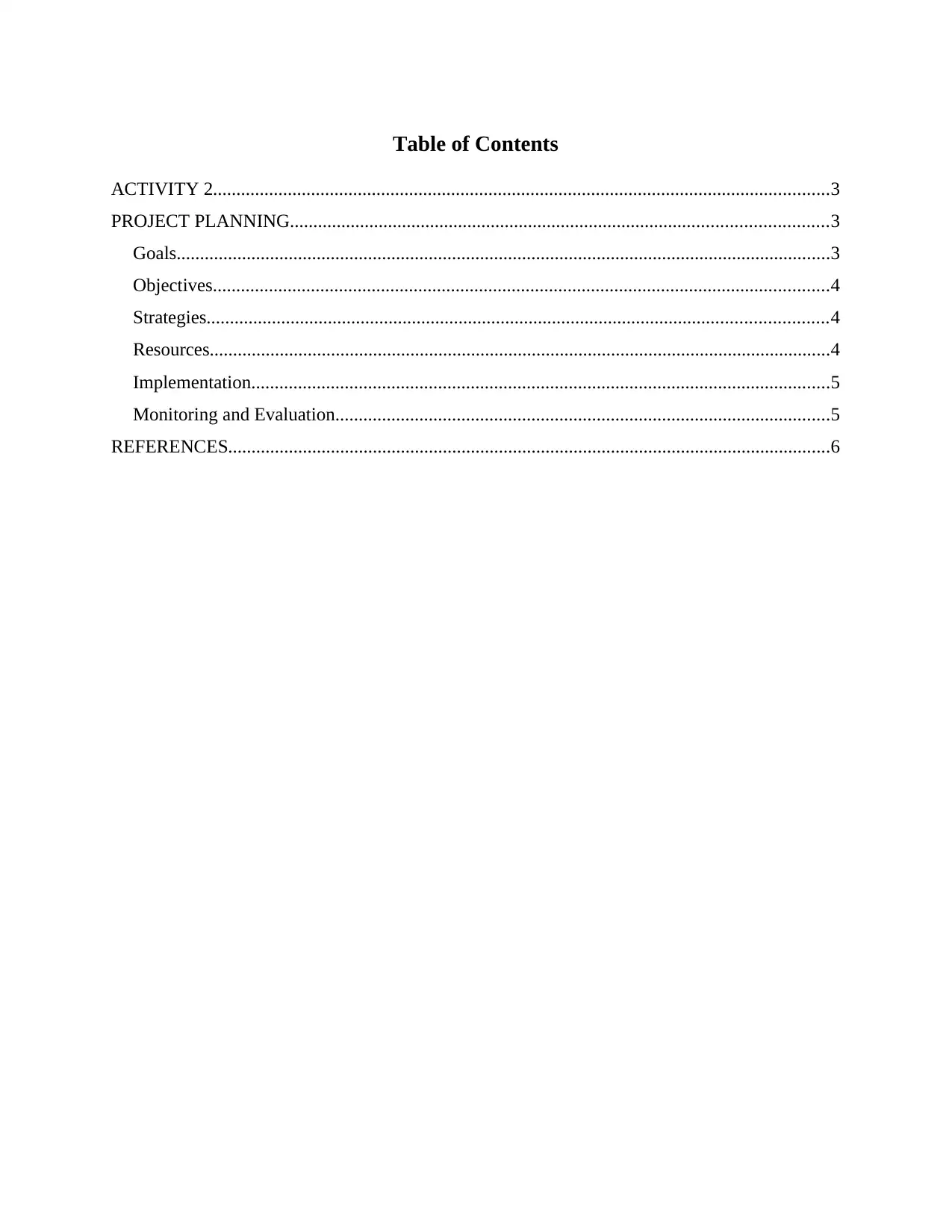
Table of Contents
ACTIVITY 2....................................................................................................................................3
PROJECT PLANNING...................................................................................................................3
Goals............................................................................................................................................3
Objectives....................................................................................................................................4
Strategies.....................................................................................................................................4
Resources.....................................................................................................................................4
Implementation............................................................................................................................5
Monitoring and Evaluation..........................................................................................................5
REFERENCES.................................................................................................................................6
ACTIVITY 2....................................................................................................................................3
PROJECT PLANNING...................................................................................................................3
Goals............................................................................................................................................3
Objectives....................................................................................................................................4
Strategies.....................................................................................................................................4
Resources.....................................................................................................................................4
Implementation............................................................................................................................5
Monitoring and Evaluation..........................................................................................................5
REFERENCES.................................................................................................................................6
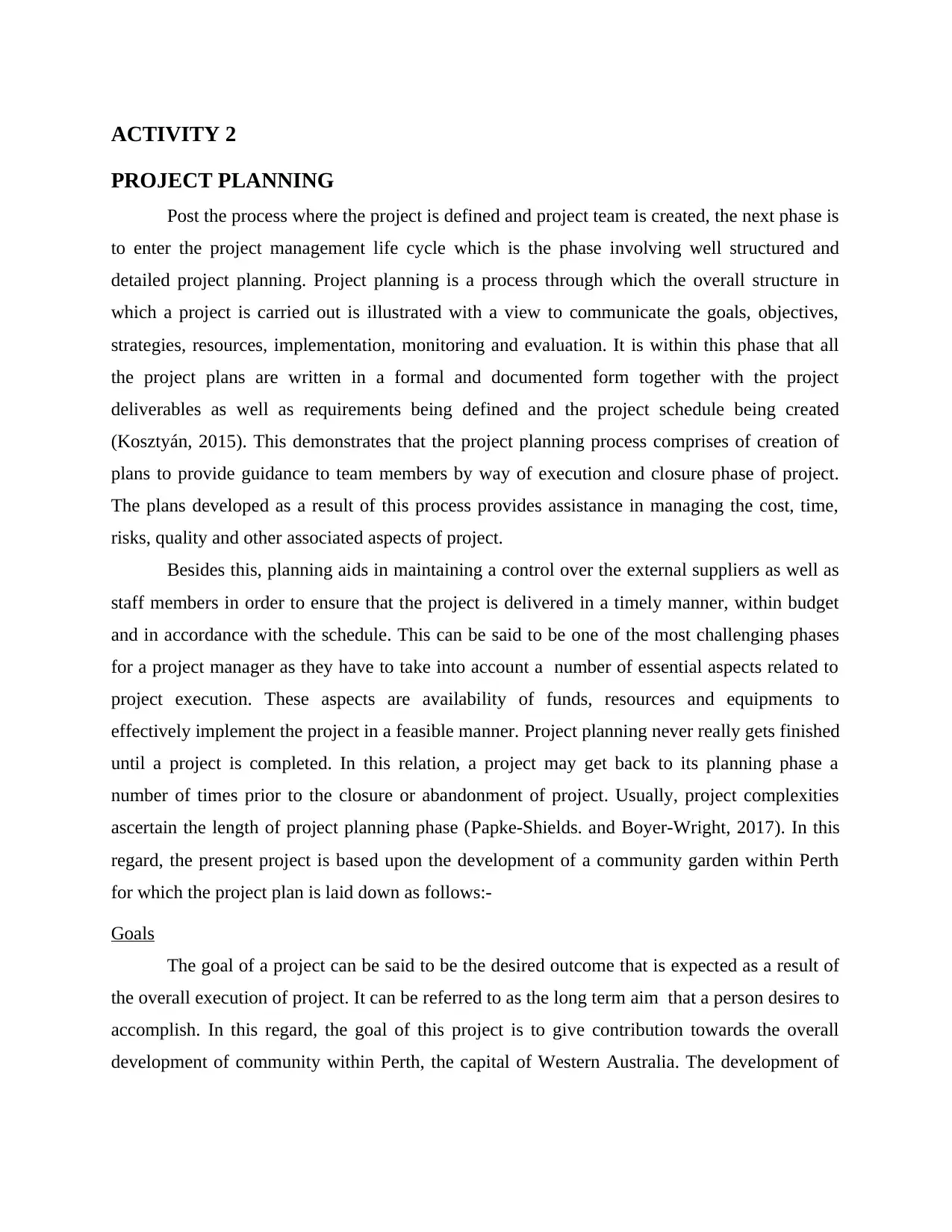
ACTIVITY 2
PROJECT PLANNING
Post the process where the project is defined and project team is created, the next phase is
to enter the project management life cycle which is the phase involving well structured and
detailed project planning. Project planning is a process through which the overall structure in
which a project is carried out is illustrated with a view to communicate the goals, objectives,
strategies, resources, implementation, monitoring and evaluation. It is within this phase that all
the project plans are written in a formal and documented form together with the project
deliverables as well as requirements being defined and the project schedule being created
(Kosztyán, 2015). This demonstrates that the project planning process comprises of creation of
plans to provide guidance to team members by way of execution and closure phase of project.
The plans developed as a result of this process provides assistance in managing the cost, time,
risks, quality and other associated aspects of project.
Besides this, planning aids in maintaining a control over the external suppliers as well as
staff members in order to ensure that the project is delivered in a timely manner, within budget
and in accordance with the schedule. This can be said to be one of the most challenging phases
for a project manager as they have to take into account a number of essential aspects related to
project execution. These aspects are availability of funds, resources and equipments to
effectively implement the project in a feasible manner. Project planning never really gets finished
until a project is completed. In this relation, a project may get back to its planning phase a
number of times prior to the closure or abandonment of project. Usually, project complexities
ascertain the length of project planning phase (Papke-Shields. and Boyer-Wright, 2017). In this
regard, the present project is based upon the development of a community garden within Perth
for which the project plan is laid down as follows:-
Goals
The goal of a project can be said to be the desired outcome that is expected as a result of
the overall execution of project. It can be referred to as the long term aim that a person desires to
accomplish. In this regard, the goal of this project is to give contribution towards the overall
development of community within Perth, the capital of Western Australia. The development of
PROJECT PLANNING
Post the process where the project is defined and project team is created, the next phase is
to enter the project management life cycle which is the phase involving well structured and
detailed project planning. Project planning is a process through which the overall structure in
which a project is carried out is illustrated with a view to communicate the goals, objectives,
strategies, resources, implementation, monitoring and evaluation. It is within this phase that all
the project plans are written in a formal and documented form together with the project
deliverables as well as requirements being defined and the project schedule being created
(Kosztyán, 2015). This demonstrates that the project planning process comprises of creation of
plans to provide guidance to team members by way of execution and closure phase of project.
The plans developed as a result of this process provides assistance in managing the cost, time,
risks, quality and other associated aspects of project.
Besides this, planning aids in maintaining a control over the external suppliers as well as
staff members in order to ensure that the project is delivered in a timely manner, within budget
and in accordance with the schedule. This can be said to be one of the most challenging phases
for a project manager as they have to take into account a number of essential aspects related to
project execution. These aspects are availability of funds, resources and equipments to
effectively implement the project in a feasible manner. Project planning never really gets finished
until a project is completed. In this relation, a project may get back to its planning phase a
number of times prior to the closure or abandonment of project. Usually, project complexities
ascertain the length of project planning phase (Papke-Shields. and Boyer-Wright, 2017). In this
regard, the present project is based upon the development of a community garden within Perth
for which the project plan is laid down as follows:-
Goals
The goal of a project can be said to be the desired outcome that is expected as a result of
the overall execution of project. It can be referred to as the long term aim that a person desires to
accomplish. In this regard, the goal of this project is to give contribution towards the overall
development of community within Perth, the capital of Western Australia. The development of
⊘ This is a preview!⊘
Do you want full access?
Subscribe today to unlock all pages.

Trusted by 1+ million students worldwide
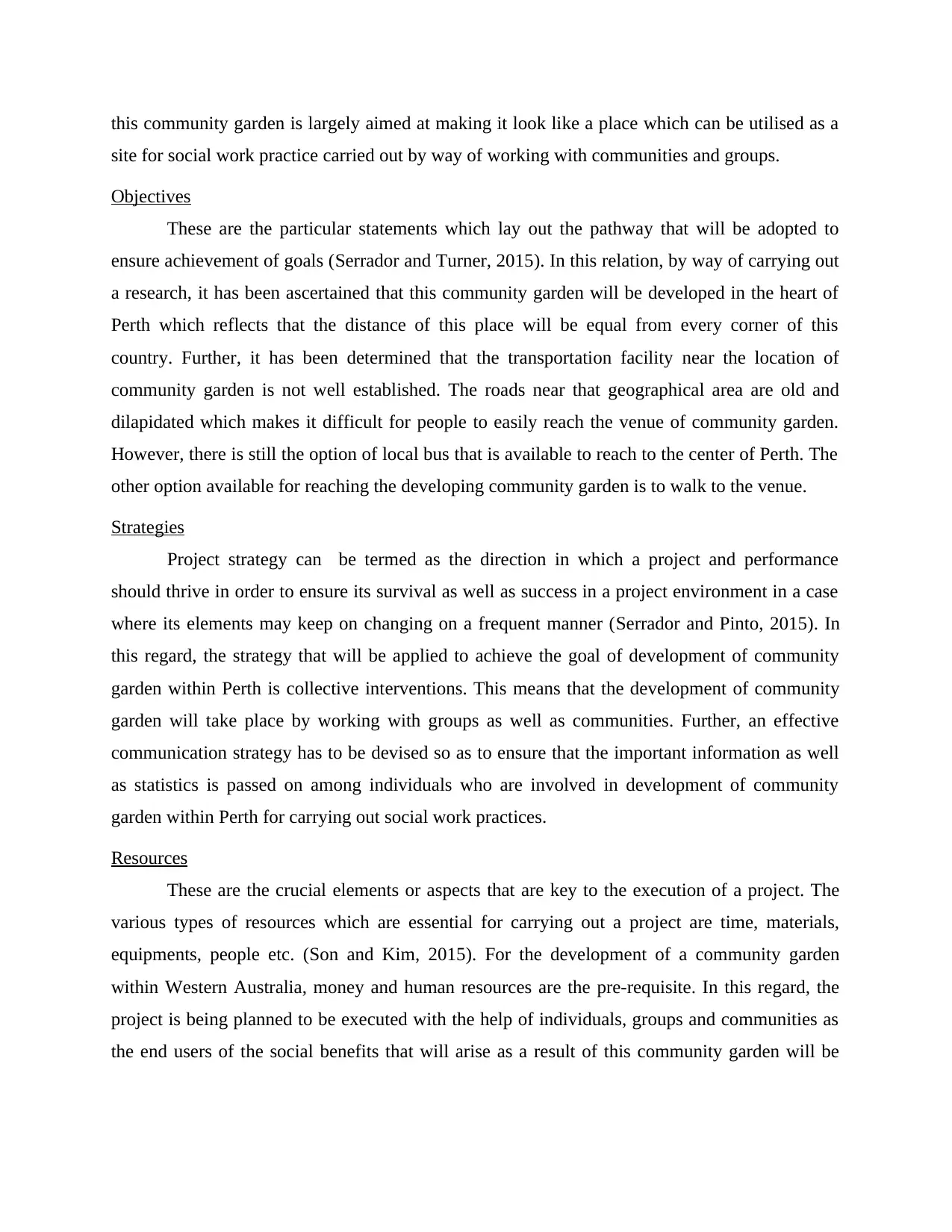
this community garden is largely aimed at making it look like a place which can be utilised as a
site for social work practice carried out by way of working with communities and groups.
Objectives
These are the particular statements which lay out the pathway that will be adopted to
ensure achievement of goals (Serrador and Turner, 2015). In this relation, by way of carrying out
a research, it has been ascertained that this community garden will be developed in the heart of
Perth which reflects that the distance of this place will be equal from every corner of this
country. Further, it has been determined that the transportation facility near the location of
community garden is not well established. The roads near that geographical area are old and
dilapidated which makes it difficult for people to easily reach the venue of community garden.
However, there is still the option of local bus that is available to reach to the center of Perth. The
other option available for reaching the developing community garden is to walk to the venue.
Strategies
Project strategy can be termed as the direction in which a project and performance
should thrive in order to ensure its survival as well as success in a project environment in a case
where its elements may keep on changing on a frequent manner (Serrador and Pinto, 2015). In
this regard, the strategy that will be applied to achieve the goal of development of community
garden within Perth is collective interventions. This means that the development of community
garden will take place by working with groups as well as communities. Further, an effective
communication strategy has to be devised so as to ensure that the important information as well
as statistics is passed on among individuals who are involved in development of community
garden within Perth for carrying out social work practices.
Resources
These are the crucial elements or aspects that are key to the execution of a project. The
various types of resources which are essential for carrying out a project are time, materials,
equipments, people etc. (Son and Kim, 2015). For the development of a community garden
within Western Australia, money and human resources are the pre-requisite. In this regard, the
project is being planned to be executed with the help of individuals, groups and communities as
the end users of the social benefits that will arise as a result of this community garden will be
site for social work practice carried out by way of working with communities and groups.
Objectives
These are the particular statements which lay out the pathway that will be adopted to
ensure achievement of goals (Serrador and Turner, 2015). In this relation, by way of carrying out
a research, it has been ascertained that this community garden will be developed in the heart of
Perth which reflects that the distance of this place will be equal from every corner of this
country. Further, it has been determined that the transportation facility near the location of
community garden is not well established. The roads near that geographical area are old and
dilapidated which makes it difficult for people to easily reach the venue of community garden.
However, there is still the option of local bus that is available to reach to the center of Perth. The
other option available for reaching the developing community garden is to walk to the venue.
Strategies
Project strategy can be termed as the direction in which a project and performance
should thrive in order to ensure its survival as well as success in a project environment in a case
where its elements may keep on changing on a frequent manner (Serrador and Pinto, 2015). In
this regard, the strategy that will be applied to achieve the goal of development of community
garden within Perth is collective interventions. This means that the development of community
garden will take place by working with groups as well as communities. Further, an effective
communication strategy has to be devised so as to ensure that the important information as well
as statistics is passed on among individuals who are involved in development of community
garden within Perth for carrying out social work practices.
Resources
These are the crucial elements or aspects that are key to the execution of a project. The
various types of resources which are essential for carrying out a project are time, materials,
equipments, people etc. (Son and Kim, 2015). For the development of a community garden
within Western Australia, money and human resources are the pre-requisite. In this regard, the
project is being planned to be executed with the help of individuals, groups and communities as
the end users of the social benefits that will arise as a result of this community garden will be
Paraphrase This Document
Need a fresh take? Get an instant paraphrase of this document with our AI Paraphraser
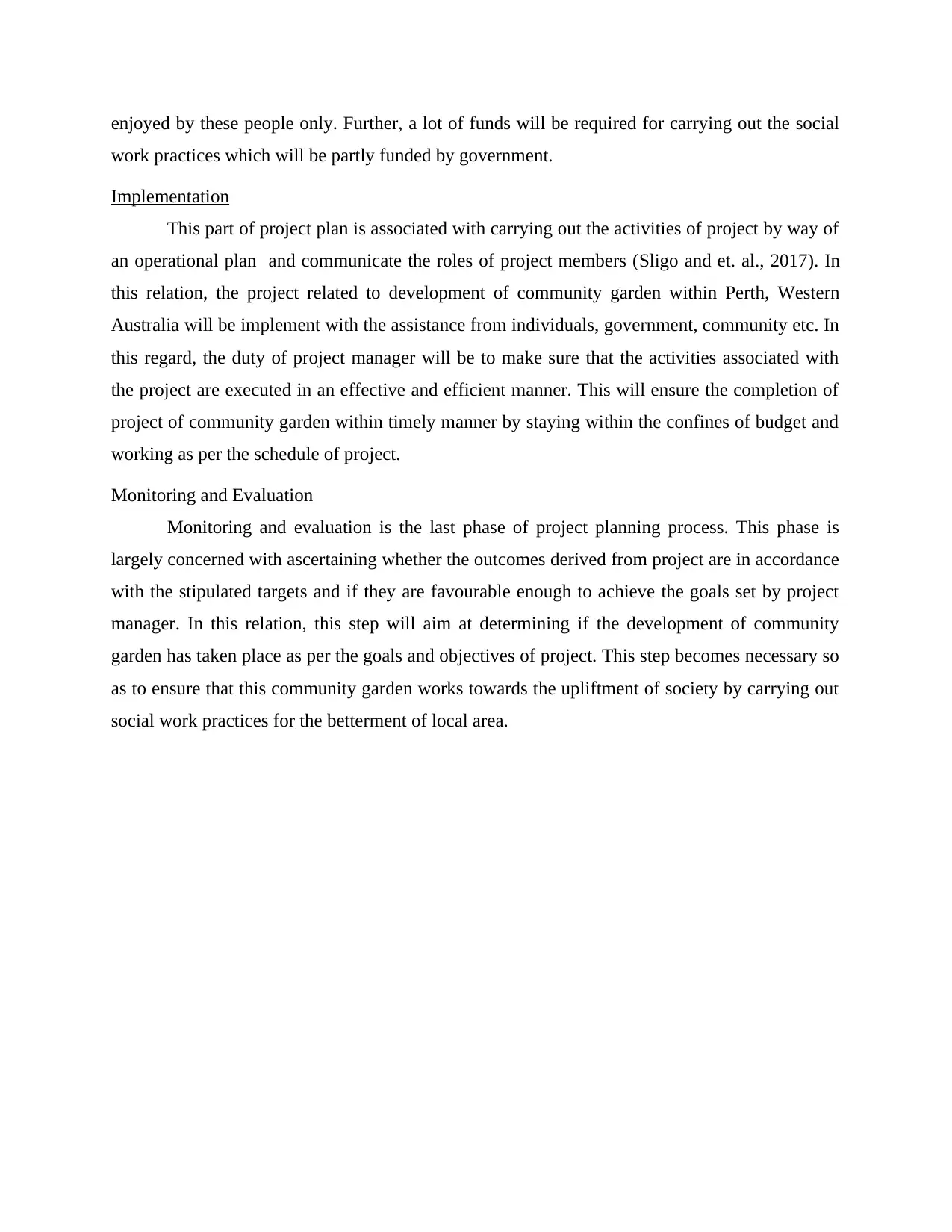
enjoyed by these people only. Further, a lot of funds will be required for carrying out the social
work practices which will be partly funded by government.
Implementation
This part of project plan is associated with carrying out the activities of project by way of
an operational plan and communicate the roles of project members (Sligo and et. al., 2017). In
this relation, the project related to development of community garden within Perth, Western
Australia will be implement with the assistance from individuals, government, community etc. In
this regard, the duty of project manager will be to make sure that the activities associated with
the project are executed in an effective and efficient manner. This will ensure the completion of
project of community garden within timely manner by staying within the confines of budget and
working as per the schedule of project.
Monitoring and Evaluation
Monitoring and evaluation is the last phase of project planning process. This phase is
largely concerned with ascertaining whether the outcomes derived from project are in accordance
with the stipulated targets and if they are favourable enough to achieve the goals set by project
manager. In this relation, this step will aim at determining if the development of community
garden has taken place as per the goals and objectives of project. This step becomes necessary so
as to ensure that this community garden works towards the upliftment of society by carrying out
social work practices for the betterment of local area.
work practices which will be partly funded by government.
Implementation
This part of project plan is associated with carrying out the activities of project by way of
an operational plan and communicate the roles of project members (Sligo and et. al., 2017). In
this relation, the project related to development of community garden within Perth, Western
Australia will be implement with the assistance from individuals, government, community etc. In
this regard, the duty of project manager will be to make sure that the activities associated with
the project are executed in an effective and efficient manner. This will ensure the completion of
project of community garden within timely manner by staying within the confines of budget and
working as per the schedule of project.
Monitoring and Evaluation
Monitoring and evaluation is the last phase of project planning process. This phase is
largely concerned with ascertaining whether the outcomes derived from project are in accordance
with the stipulated targets and if they are favourable enough to achieve the goals set by project
manager. In this relation, this step will aim at determining if the development of community
garden has taken place as per the goals and objectives of project. This step becomes necessary so
as to ensure that this community garden works towards the upliftment of society by carrying out
social work practices for the betterment of local area.
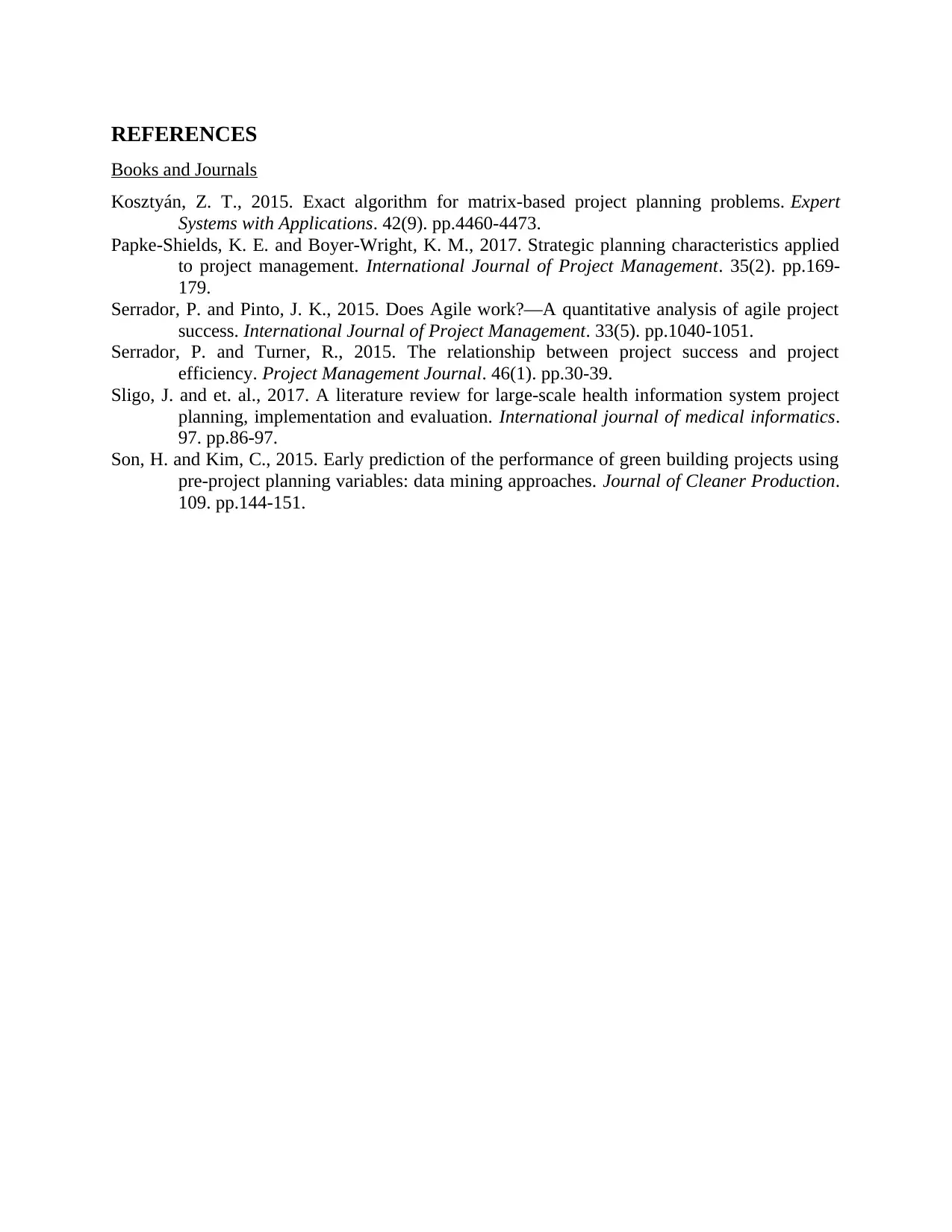
REFERENCES
Books and Journals
Kosztyán, Z. T., 2015. Exact algorithm for matrix-based project planning problems. Expert
Systems with Applications. 42(9). pp.4460-4473.
Papke-Shields, K. E. and Boyer-Wright, K. M., 2017. Strategic planning characteristics applied
to project management. International Journal of Project Management. 35(2). pp.169-
179.
Serrador, P. and Pinto, J. K., 2015. Does Agile work?—A quantitative analysis of agile project
success. International Journal of Project Management. 33(5). pp.1040-1051.
Serrador, P. and Turner, R., 2015. The relationship between project success and project
efficiency. Project Management Journal. 46(1). pp.30-39.
Sligo, J. and et. al., 2017. A literature review for large-scale health information system project
planning, implementation and evaluation. International journal of medical informatics.
97. pp.86-97.
Son, H. and Kim, C., 2015. Early prediction of the performance of green building projects using
pre-project planning variables: data mining approaches. Journal of Cleaner Production.
109. pp.144-151.
Books and Journals
Kosztyán, Z. T., 2015. Exact algorithm for matrix-based project planning problems. Expert
Systems with Applications. 42(9). pp.4460-4473.
Papke-Shields, K. E. and Boyer-Wright, K. M., 2017. Strategic planning characteristics applied
to project management. International Journal of Project Management. 35(2). pp.169-
179.
Serrador, P. and Pinto, J. K., 2015. Does Agile work?—A quantitative analysis of agile project
success. International Journal of Project Management. 33(5). pp.1040-1051.
Serrador, P. and Turner, R., 2015. The relationship between project success and project
efficiency. Project Management Journal. 46(1). pp.30-39.
Sligo, J. and et. al., 2017. A literature review for large-scale health information system project
planning, implementation and evaluation. International journal of medical informatics.
97. pp.86-97.
Son, H. and Kim, C., 2015. Early prediction of the performance of green building projects using
pre-project planning variables: data mining approaches. Journal of Cleaner Production.
109. pp.144-151.
⊘ This is a preview!⊘
Do you want full access?
Subscribe today to unlock all pages.

Trusted by 1+ million students worldwide
1 out of 6
Related Documents
Your All-in-One AI-Powered Toolkit for Academic Success.
+13062052269
info@desklib.com
Available 24*7 on WhatsApp / Email
![[object Object]](/_next/static/media/star-bottom.7253800d.svg)
Unlock your academic potential
Copyright © 2020–2025 A2Z Services. All Rights Reserved. Developed and managed by ZUCOL.





